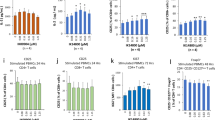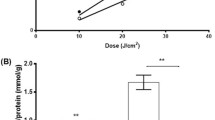Abstract
We tested the hypothesis that DNA is a target for solar-simulated ultraviolet radiation (ssUVR)-induced suppression of the reactivation of memory immunity in humans. T4N5 liposomes contain the DNA repair enzyme T4 endonuclease V. This cleaves DNA at the site of ultraviolet radiation (UVR)-induced cyclobutane pyrimidine dimers (CPD), initiating DNA repair. It has previously been used to show that CPDs are a key molecular trigger for UVR-induced immunosuppression in mice. To determine whether CPD formation is involved in UVR immunosuppression in humans, nickel-allergic volunteers were irradiated with a range of doses of ssUVR. T4N5 or empty liposomes were then applied after irradiation. Nickel-induced recall immunity was assessed by reflectance spectrometry. T4N5 liposomes inhibited immunosuppression and prevented ssUVR from reducing the number of epidermal dendritic cells. T4N5 liposomes also reduced macrophage infiltration into irradiated epidermis. These studies show that enhanced removal of CPDs from human skin protects from immunosuppression, hence demonstrating that these photolesions are an important molecular event in ssUVR-induced immunosuppression in humans. CPDs also triggered loss of dendritic cells and infiltration by macrophages. It is possible that these changes to antigen presenting cells contribute to ssUVR induced suppression of recall immunity to nickel in humans.
Similar content being viewed by others
Refences
B. K. Armstrong, A. Kricker The epidemiology of UV induced skin cancer J. Photochem. Photobiol. B: Biol. 2001 63 8–18
D. L. Damian, G. M. Halliday, R. S. Barnetson Low-dose UVA and UVB have different time courses for suppression of contact hypersensitivity to a recall antigen in humans J. Invest. Dermatol. 1999 112 939–944
N. S. Agar, G. M. Halliday, R. S. Barnetson, H. N. Ananthaswamy, M. Wheeler, A. M. Jones The basal layer in human squamous tumors harbors more UVA than UVB fingerprint mutations: A role for UVA in human skin carcinogenesis Proc. Natl. Acad. Sci. USA 2004 101 4954–4959
D. E. Brash, A. Ziegler, A. S. Jonason, J. A. Simon, S. Kunala, D. J. Leffell Sunlight and sunburn in human skin cancer: p53, apoptosis, and tumor promotion J. Invest. Dermatol. Symp. Proc. 1996 1 136–42
Y. Matsumura, H. N. Ananthaswamy Toxic effects of ultraviolet radiation on the skin Toxicol. Appl. Pharmacol 2004 195 298–308
D. Yarosh, L. G. Alas, V. Yee, A. Oberyszyn, J. T. Kibitel, D. Mitchell, R. Rosenstein, A. Spinowitz, M. Citron Pyrimidine dimer removal enhanced by DNA repair liposomes reduces the incidence of UV skin cancer in mice Cancer Res. 1992 52 4227–31
D. B. Yarosh Liposomes in investigative dermatology [Review] Photodermatol., Photoimmunol. Photomed. 2001 17 203–212
A. A. Vink, F. M. Strickland, C. Bucana, P. A. Cox, L. Roza, D. B. Yarosh, M. L. Kripke Localization of DNA damage and its role in altered antigen-presenting cell function in ultraviolet-irradiated mice J. Exp. Med. 1996 183 1491–1500
M. L. Kripke, P. A. Cox, L. G. Alas, D. B. Yarosh Pyrimidine dimers in DNA initiate systemic immunosuppression in UV-irradiated mice Proc. Natl. Acad. Sci. USA 1992 89 7516–7520
P. Wolf, P. Cox, D. B. Yarosh, M. L. Kripke Sunscreens and T4N5 liposomes differ in their ability to protect against ultraviolet-induced sunburn cell formation, alterations of dendritic epidermal cells, and local suppression of contact hypersensitivity J Invest. Dermatol. 1995 104 287–292
A. A. Vink, D. B. Yarosh, M. L. Kripke Chromophore For UV-induced immunosuppression-DNA Photochem. Photobiol. 1996 63 383–386
T. Schwarz Photoimmunosuppression Photodermatol., Photoimmunol. Photomed. 2002 18 141–145
D. Yarosh, J. Klein, A. O’Connor, J. Hawk, E. Rafal, P. Wolf Effect of topically applied T4 endonuclease V in liposomes on skin cancer in xeroderma pigmentosum: a randomised study Lancet. 2001 357 926–929
D. L. Damian, G. M. Halliday, R. S. Barnetson Broad-spectrum sunscreens provide greater protection against ultraviolet-radiation-induced suppression of contact hypersensitivity to a recall antigen in humans J. Invest. Dermatol. 1997 109 146–151
D. L. Damian, G. M. Halliday Measurement of ultraviolet radiation-induced suppression of recall contact and delayed-type hypersensitivity in humans Methods 2002 28 34–45
J. M. Kuchel, R. S. Barnetson, G. M. Halliday Nitric oxide appears to be a mediator of solar-simulated ultraviolet radiation-induced immunosuppression in humans J. Invest. Dermatol. 2003 121 587–593
J. M. Kuchel, R. S. C. Barnetson, G. M. Halliday Ultraviolet A augments solar-simulated ultraviolet radiation-induced local suppression of recall responses in humans J. Invest. Dermatol. 2002 118 1032–1037
A. Patel, G. M. Halliday, B. E. Cooke, R. S. Barnetson Evidence that regression in keratoacanthoma is immunologically mediated: a comparison with squamous cell carcinoma Br. J. Dermatol. 1994 131 789–98
M. S. Duthie, I. Kimber, M. Norval The effects of ultraviolet radiation on the human immune system [Review] Br. J. Dermatol. 1999 140 995–1009
D. X. Nghiem, N. Kazimi, D. L. Mitchell, A. A. Vink, H. N. Ananthaswamy, M. L. Kripke, S. E. Ullrich Mechanisms underlying the suppression of established immune responses by ultraviolet radiation J. Invest. Dermatol. 2002 119 600–608
H. Stege, L. Roza, A. A. Vink, M. Grewe, T. Ruzicka, S. Grether-Beck, J. Krutmann Enzyme plus light therapy to repair DNA damage in ultraviolet-B-irradiated human skin Proc. Natl. Acad. Sci. USA 2000 97 1790–1795
G. Stingl, P. R. Bergstresser Dendritic cells: A major story unfolds Immunol. Today 1995 16 330–333
G. W. Dandie, G. J. Clydesdale, I. Jacobs, H. K. Muller Effects of UV on the migration and function of epidermal antigen presenting cells Mutat. Res. 1998 422 147–154
G. W. Dandie, G. J. Clydesdale, F. J. Radcliff, H. K. Muller Migration of Langerhans cells and gamma delta(+) dendritic cells from UV-B-irradiated sheep skin Immunol. Cell Biol. 2001 79 41–48
A. M. Moodycliffe, I. Kimber, M. Norval The effect of ultraviolet-B irradiation and urocanic acid isomers on dendritic cell migration Immunology 1992 77 394–399
Y. Sontag, C. L. H. Guikers, A. A. Vink, F. R. Degruijl, H. Vanloveren, J. Garssen, L. Roza, M. L. Kripke, J. C. Vanderleun, W. A. Vanvloten Cells with UV-specific DNA damage are present in murine lymph nodes after in vivo UV irradiation J. Invest. Dermatol. 1995 104 734–738
D. Yarosh, C. Bucana, P. Cox, L. Alas, J. Kibitel, M. Kripke Localization of liposomes containing a DNA repair enzyme in murine skin J. Invest. Dermatol. 1994 103 461–468
A. Schwarz, S. Stander, M. Berneburg, M. Bohm, D. Kulms, H. van Steeg, K. Grosse-Heitmeyer, J. Krutmann, T. Schwarz Interleukin-12 suppresses ultraviolet radiation-induced apoptosis by inducing DNA repair Nat. Cell Biol. 2002 4 26–31
A. Schwarz, A. Maeda, K. Kernebeck, H. van Steeg, S. Beissert, T. Schwarz Prevention of UV radiation-induced immunosuppression by IL-12 is dependent on DNA repair J. Exp. Med. 2005 201 173–179
K. D. Cooper, L. Oberhelman, T. A. Hamilton, O. Baadsgaard, M. Terhune, G. Levee, T. Anderson, H. Koren UV exposure reduces immunization rates and promotes tolerance to epicutaneous antigens in humans-relationship to dose, CD1a-DR+ epidermal macrophage induction, and Langerhans cell depletion Proc. Natl. Acad. Sci. USA 1992 89 8497–8501
C. Hammerberg, N. Duraiswamy, K. D. Cooper Active induction of unresponsiveness (tolerance) to DNFB by in vivo ultraviolet-exposed epidermal cells is dependent upon infiltrating class II MHC(+) CD11b(bright) monocytic/macrophagic cells J. Immunol. 1994 153 4915–4924
R. Sluyter, G. M. Halliday Enhanced tumor growth in UV-irradiated skin is associated with an influx of inflammatory cells into the epidermis Carcinogenesis 2000 21 1801–1807
K. F. Kang, C. Hammerberg, L. Meunier, K. D. Cooper CD11b(+) macrophages that infiltrate human epidermis after in vivo ultraviolet exposure potently produce IL-10 and represent the major secretory source of epidermal IL-10 protein J. Immunol. 1994 153 5256–5264
C. Nishigori, D. B. Yarosh, S. E. Ullrich, A. A. Vink, C. D. Bucana, L. Roza, M. L. Kripke Evidence that DNA damage triggers interleukin 10 cytokine production in UV-irradiated murine keratinocytes Proc. Natl. Acad. Sci. USA 1996 93 10354–10359
Author information
Authors and Affiliations
Corresponding author
Rights and permissions
About this article
Cite this article
Kuchel, J.M., Barnetson, R.S.C. & Halliday, G.M. Cyclobutane pyrimidine dimer formation is a molecular trigger for solar-simulated ultraviolet radiation-induced suppression of memory immunity in humans. Photochem Photobiol Sci 4, 577–582 (2005). https://doi.org/10.1039/b504068j
Received:
Accepted:
Published:
Issue Date:
DOI: https://doi.org/10.1039/b504068j




